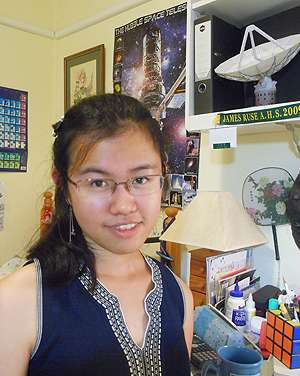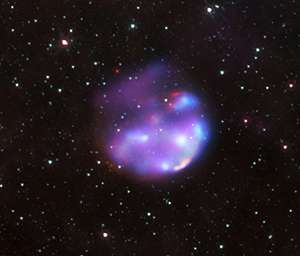Student helps investigate a stellar 'crime scene'

(Phys.org) —An undergraduate astronomy student at the University of Sydney is proud to have played her part in investigating NASA's discovery of the remains of a shattered star.
"It is a thrill to be able to examine this new object, which ranks among the youngest known supernova remnants in our Milky Way galaxy," said Cleo Loi, who is in her fourth year of a combined Bachelor of Science and Bachelor of Engineering.
Loi first got involved with the research as part of an undergraduate physics vacation scholarship and continued with it as a senior physics special project.
Designated G306.3-0.9 after the coordinates of its sky position, the object was uncovered by NASA's Swift satellite while it was performing an extensive x-ray survey of our galaxy's central regions.
An article on the discovery, on which Cleo Loi is the second author, has been published in The Astrophysical Journal.
"Astronomers have previously catalogued more than 300 supernova remnants in the galaxy," said lead scientist Mark Reynolds, a postdoctoral researcher at the University of Michigan.

"Our analysis indicates that G306.3-0.9 is likely less than 2500 years old, making it one of the 20 youngest remnants identified."
Like fresh evidence at a crime scene, young supernova remnants give astronomers the best opportunity for understanding the nature of the original star and the details of its demise.
Supernova remnants emit energy across the electromagnetic spectrum, from radio to gamma rays, and important clues can be found in each energy band. X-ray observations figure prominently in revealing the motion of the expanding debris, its chemical content, and its interaction with the interstellar environment, but supernova remnants fade out in x-ray light after 10,000 years. Indeed, only half of those known in the Milky Way galaxy have been detected in X-rays at all.
The Swift Galactic Plane Survey's aim is to image a two degree-wide strip along the Milky Way's central plane. Swift carries multiple telescopes on board, three in total. One is a gamma-ray telescope, one is an X-ray telescope and the last is an ultraviolet-wavelength telescope, side-by-side and operating simultaneously. So there are parallel data streams coming in from the X-ray and UV telescopes, both observing the same part of the sky at the same time.
"Following the discovery of G306.3-0.9 at x-ray wavelengths, it was found that a counterpart at radio wavelengths in fact already existed in the archives of the Molonglo Observatory Synthesis Telescope, a radio observatory near Canberra, Australia," said Cleo Loi.
"However, the resolution was too low to make out anything but the largest scale features, and so additional radio observations from the Australia Telescope Compact Array (ATCA) were requested. I was flown to Narrabri, New South Wales, where the ATCA is located, and had the privilege of operating the telescope single-handedly for an overnight observing run. I then led the effort to process and analyse the radio data over the subsequent months."
"The fantastic sensitivity of ATCA has enabled us to image what, at radio wavelengths, turns out to be the dimmest remnant we have ever seen in our galaxy.G306.3-0.9 is on par with other known galactic remnants in terms of average surface brightness, but its small angular size means that the radio power we receive from it is very low."
It is suspected that there is a whole undiscovered population of young supernova remnants scattered through the Milky Way which, like G306.3-0.9, have been overlooked by past radio surveys due to their small angular size and resulting dimness.
Loi is an enthusiastic researcher who has been doing undergraduate projects continuously since her second semester of university in astronomy, microscopy, brain dynamics, solar physics and quantum physics, alongside her coursework.
"I eventually hope to go into scientific research and academia. I'm keeping my options open but am leaning towards astrophysics."
More information: iopscience.iop.org/0004-637X/766/2/112
Journal information: Astrophysical Journal
Provided by University of Sydney





















